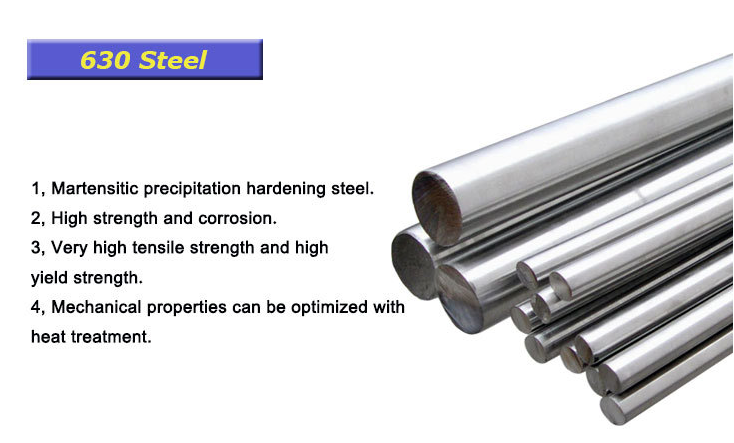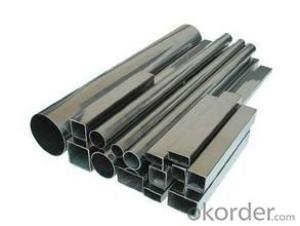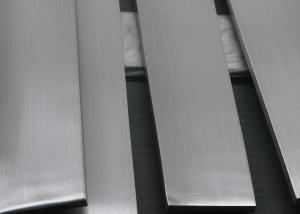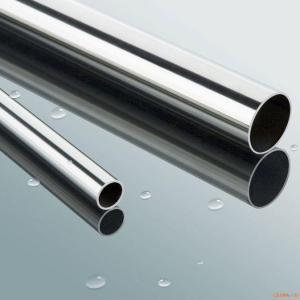okorder gold supplier en1.4301 stainless steel bar
- Loading Port:
- Tianjin
- Payment Terms:
- TT OR LC
- Min Order Qty:
- 100 kg
- Supply Capability:
- 1000 kg/month
OKorder Service Pledge
Quality Product, Order Online Tracking, Timely Delivery
OKorder Financial Service
Credit Rating, Credit Services, Credit Purchasing
You Might Also Like




- Q: What is stainless steel pipe?
- Stainless steel pipe is a type of pipe made from an alloy of steel and chromium, which provides excellent resistance to corrosion and oxidation. It is commonly used in various industries, including construction, automotive, and manufacturing, due to its durability, strength, and aesthetic appeal. Stainless steel pipes are known for their ability to withstand high temperatures and pressure, making them suitable for applications that involve transporting fluids and gases. Additionally, they are available in various sizes, shapes, and grades to meet specific requirements. Whether in residential or industrial settings, stainless steel pipes are widely used for plumbing, water supply systems, HVAC systems, and many other applications where durability and corrosion resistance are essential.
- Q: Can stainless steel pipes handle extreme weather conditions?
- Yes, stainless steel pipes are known for their excellent durability and resistance to extreme weather conditions. They can withstand high temperatures, heavy rains, strong winds, and even harsh chemicals without corroding or deteriorating. The inherent properties of stainless steel, such as its high strength, corrosion resistance, and heat resistance, make it an ideal choice for outdoor applications and extreme weather conditions. Stainless steel pipes can handle extreme heat and cold, as well as resist the effects of UV radiation and oxidation. These pipes are often used in industries such as oil and gas, chemical processing, construction, and marine applications, where they are subjected to harsh environments. Overall, stainless steel pipes are a reliable and long-lasting solution for handling extreme weather conditions.
- Q: How do you prevent pressure loss in stainless steel pipes?
- To prevent pressure loss in stainless steel pipes, there are a few key measures that can be taken: 1. Proper pipe sizing: Ensure that the diameter of the stainless steel pipe is appropriate for the flow rate and pressure requirements of the system. Undersized pipes can result in increased pressure loss due to higher fluid velocities. 2. Minimize pipe length and bends: Keep the length of the stainless steel pipe as short as possible and reduce the number of bends or elbows. Longer pipes and multiple bends introduce friction and turbulence, leading to pressure loss. 3. Smooth interior surface: Use stainless steel pipes with a smooth interior surface finish. This helps to reduce frictional resistance and turbulence, thereby minimizing pressure loss. 4. Avoid unnecessary fittings and valves: Each fitting or valve in a stainless steel pipe system introduces additional pressure loss. Minimize the use of unnecessary fittings and valves, and opt for those with low resistance to maintain pressure. 5. Proper installation: Ensure that the stainless steel pipes are installed correctly, with proper alignment and support. Misaligned or poorly supported pipes can lead to excessive stress and potential deformation, causing pressure loss. 6. Regular maintenance and cleaning: Periodically inspect and clean the stainless steel pipes to remove any accumulated scale, debris, or deposits. Such obstructions can restrict flow and result in pressure loss. 7. Consider flow control devices: Depending on the application, incorporating flow control devices like flow restrictors, pressure regulators, or flow meters can help maintain optimal pressure levels in the stainless steel pipe system. By following these measures, pressure loss in stainless steel pipes can be minimized, ensuring efficient and effective fluid transportation within the system.
- Q: How are stainless steel pipes graded?
- The quality and suitability of stainless steel pipes are determined by various factors, resulting in their grading. The grading system takes into consideration factors such as chemical composition, mechanical properties, and manufacturing process. When grading stainless steel pipes, a crucial aspect is their chemical composition. This refers to the specific elements present in the alloy and their quantities. Common elements found in stainless steel pipes are chromium, nickel, molybdenum, and carbon. The percentage of these elements affects the strength, durability, and corrosion resistance of the pipes. Different grades of stainless steel pipes have different compositions, allowing them to be used in various environments and applications. Another factor considered in grading stainless steel pipes is their mechanical properties, including tensile strength, yield strength, and elongation. These properties determine how the pipes perform under different conditions and their structural integrity. Higher grades of stainless steel pipes generally possess superior mechanical properties, making them suitable for applications involving high pressure and temperature. The manufacturing process also plays a vital role in grading stainless steel pipes. The pipes undergo processes such as hot rolling, cold rolling, and heat treatment to shape them and enhance their properties. The quality of the manufacturing process greatly impacts the final grade of the stainless steel pipes. Pipes produced using advanced techniques and strict quality control measures are usually assigned higher grades. In conclusion, stainless steel pipes are graded based on their chemical composition, mechanical properties, and manufacturing process. These grading criteria ensure that different grades of stainless steel pipes are available to meet the specific requirements of different industries and applications.
- Q: Are stainless steel pipes suitable for fire protection systems?
- Indeed, fire protection systems find stainless steel pipes to be a suitable option. The reason lies in the fact that stainless steel possesses remarkable resistance against corrosion, a trait of utmost importance for fire protection systems, which frequently encounter water or other corrosive substances. The ability of stainless steel pipes to endure high temperatures while preserving their structural integrity enhances their dependability for the transportation of water or other fire suppressants. Furthermore, the durability and extended lifespan of stainless steel pipes contribute to a decrease in the necessity for frequent replacements or repairs. All in all, stainless steel pipes are widely favored in fire protection systems due to their reliability, resistance to corrosion, and durability.
- Q: How do stainless steel pipes compare to ductile iron pipes?
- Stainless steel pipes and ductile iron pipes have different characteristics and applications. Stainless steel pipes offer excellent corrosion resistance, making them suitable for various industries, including food processing and chemical plants. On the other hand, ductile iron pipes are known for their strength and durability, making them commonly used in water distribution systems and sewer lines. Ultimately, the choice between stainless steel and ductile iron pipes depends on the specific needs and requirements of the project or application.
- Q: What are the common applications for stainless steel pipes?
- The unique properties and versatility of stainless steel pipes make them suitable for a wide range of applications. Some common uses include: 1. Plumbing and water supply systems: Stainless steel pipes are commonly employed in plumbing and water supply systems because of their resistance to corrosion and ability to withstand high pressure. They provide a reliable and long-lasting solution for transporting water and other fluids. 2. Oil and gas industry: Stainless steel pipes are extensively utilized in the oil and gas industry for the transportation of oil, gas, and other hydrocarbons. Their ability to withstand high temperatures and pressures makes them suitable for exploration, production, and transportation of these resources. 3. Food and beverage industry: The hygienic properties and corrosion resistance of stainless steel pipes make them widely used in the food and beverage industry. They are commonly employed for transporting liquids, such as milk, juices, and processed foods, ensuring the safety and quality of the products. 4. Chemical and pharmaceutical industry: Stainless steel pipes, being highly resistant to corrosion, are ideal for the chemical and pharmaceutical industry. They are used for transporting various chemicals, acids, and solvents, ensuring the integrity of the substances being transported. 5. Construction and architecture: Stainless steel pipes are utilized in construction and architectural applications due to their aesthetic appeal and structural strength. They are often used for handrails, balustrades, structural columns, and decorative purposes, adding a modern and sleek look to buildings. 6. Automotive industry: Stainless steel pipes are used in the automotive industry for exhaust systems because of their heat resistance and durability. They can withstand high temperatures and corrosive gases, ensuring the efficient operation of the exhaust system. 7. Power generation: Stainless steel pipes find application in power plants for the transportation of steam, water, and other fluids. They are resistant to high temperatures and pressures, making them suitable for power generation purposes. 8. Aerospace industry: Stainless steel pipes are employed in the aerospace industry for various applications, including aircraft exhaust systems, hydraulic systems, and fuel lines. They offer a high strength-to-weight ratio, corrosion resistance, and reliability, meeting the stringent requirements of the aerospace industry. In conclusion, stainless steel pipes are utilized in various industries due to their corrosion resistance, durability, and versatility. They find applications in plumbing, oil and gas, food and beverage, chemical and pharmaceutical, construction, automotive, power generation, and aerospace industries, among others.
- Q: What is the difference between schedule 10 and schedule 160 stainless steel pipes?
- The main difference between schedule 10 and schedule 160 stainless steel pipes is their thickness and pressure rating. Schedule 10 pipes have a thinner wall thickness and a lower pressure rating compared to schedule 160 pipes, which have a thicker wall thickness and a higher pressure rating. Additionally, schedule 160 pipes are typically used for high-pressure applications, while schedule 10 pipes are suitable for low to medium-pressure applications.
- Q: How do you calculate the flow rate of stainless steel pipes?
- The flow rate of stainless steel pipes can be calculated using the formula: Q = A × V, where Q represents the flow rate, A is the cross-sectional area of the pipe, and V is the velocity of the fluid flowing through the pipe.
- Q: Can stainless steel pipes be used for hydraulic systems?
- Stainless steel pipes are a suitable option for hydraulic systems as they possess high durability and resistance to corrosion. This material can withstand high pressure and extreme temperatures, making it a dependable choice for hydraulic applications. In addition, stainless steel pipes exhibit exceptional resistance to chemical and environmental elements, guaranteeing the longevity and reliability of the hydraulic system. Moreover, these pipes provide excellent dimensional stability, which is critical for maintaining the integrity and efficiency of the hydraulic system. In summary, stainless steel pipes are widely favored for hydraulic systems due to their durable nature, corrosion resistance, and exceptional performance capabilities.
Send your message to us
okorder gold supplier en1.4301 stainless steel bar
- Loading Port:
- Tianjin
- Payment Terms:
- TT OR LC
- Min Order Qty:
- 100 kg
- Supply Capability:
- 1000 kg/month
OKorder Service Pledge
Quality Product, Order Online Tracking, Timely Delivery
OKorder Financial Service
Credit Rating, Credit Services, Credit Purchasing
Similar products
Hot products
Hot Searches
Related keywords
























